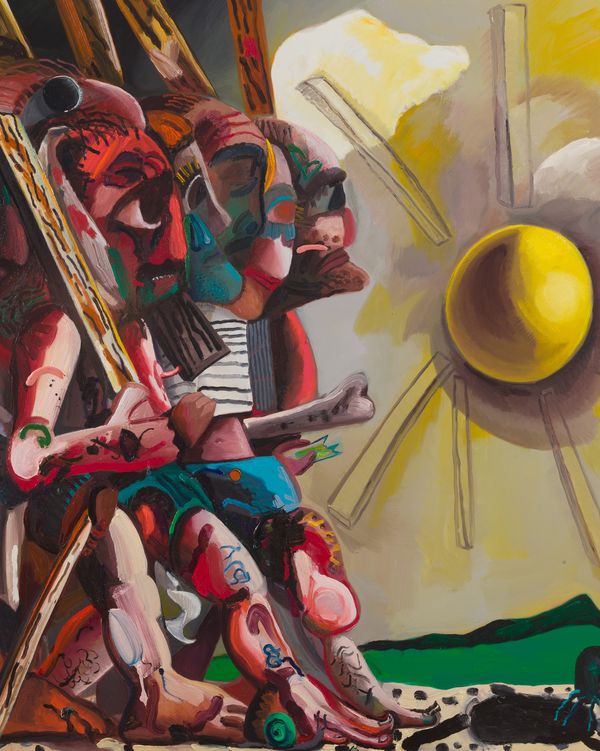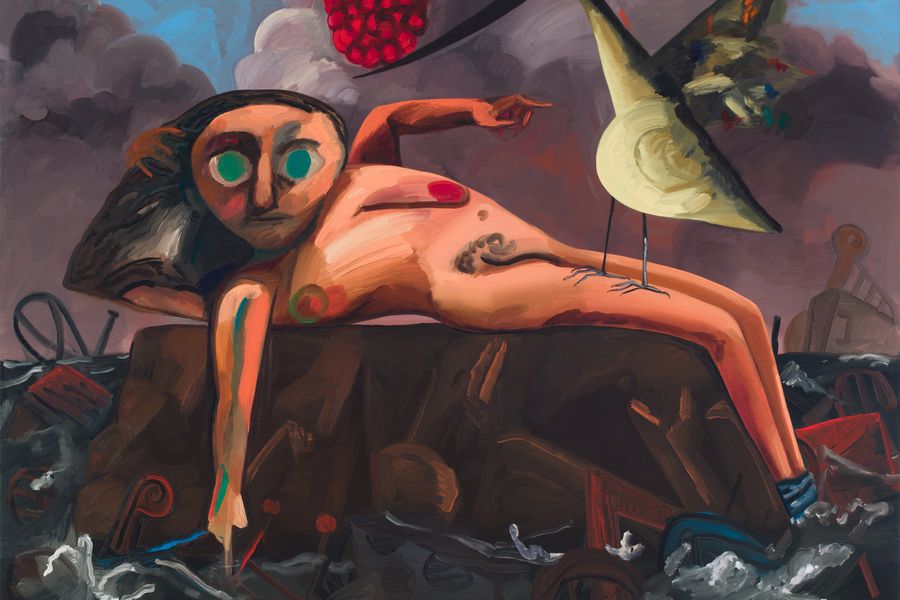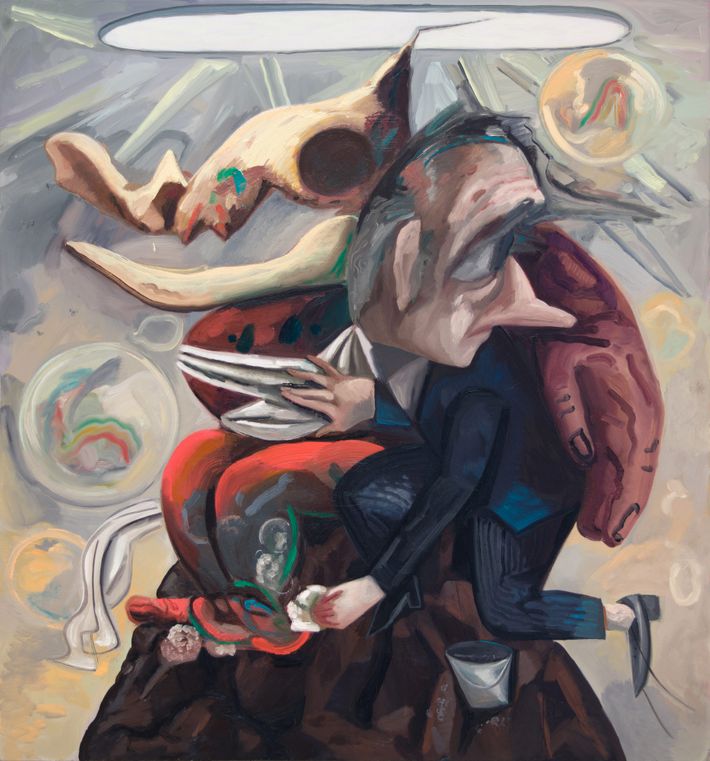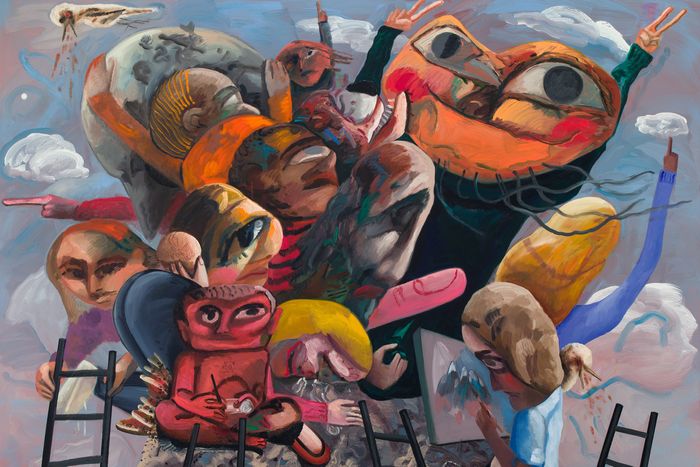
In her new work, artist Dana Schutz takes back her painterly name. Her current canvasses are hyperassertive, full of operatic grandeur, self-mocking turbulence, acidified flooded color, disfigured hideousness, and the psychopathology of her figures — all clawing in some Malthusian struggle for existence. Like this work or not, Schutz is claiming a lot of visual territory for herself. This means more tenacity in the paint, irrepressible surfaces, ambitious scale, and mixed — conflicted — compositional structures.
The cosmic background radiation and explosive blowback of what Schutz triggered in 2017 are still here, of course. How could they not be? Painting is a kind of time machine: Just as the speed of light and sound are experienced after the fact so, too, is the speed of art — things like stress, shock, conflict, phobia, admissions of complicity, and crushing psychological weight emerge only later in one’s work.
All these things — and a new painterly savageness — are present in Schutz’s first show in New York since the 2017 Whitney Biennial. It was then that her Open Casket, a small, widely contested painting based on the famous photograph of the mutilated Emmett Till — who in 1955 was murdered by two white men — became the center of one of the fiercest political storms in decades. One that found Schutz protested not by the right wing but — rightly — by the art world itself. More on that in a moment.
Schutz has poured all of this and much more into her new, vivid paintings. This is good because not only does it suggest that she won’t be reduced to just being “the Open Casket artist,” but because for two years before the Whitney protests, her work had stalled in an overly controlled, flattened fracturing Cubo-Futurism. Schutz’s light was flickering off. Here it blazes back on. A few of the 11 paintings (and five bronzes) here are among the best things she’s ever made and point to better things yet.
Witness the cataclysm of the almost 12-foot-long, 9-foot-high Visible World — a personal Raft of the Medusa, perhaps. A naked Olympia odalisque, Promethean female figure is laid out on a rock amid stormy black seas. Her feet are bound in rope or her own underpants. A great green bird with paintbrushlike wings perches on her thighs; in its wide-open beak it bears what looks like a raspberry arachnid egg sack or other fungal growth. Maybe it’s offering sustenance. An ark is visible on one side; bobbing broken furniture and barrels on the other; drowning figures dot the foreground. The woman’s expression recapitulates Picasso’s late wide-eyed-zombie death-mask self-portraits as she peers at us with saucer Demoiselles d’Avignon eyes.
Many of the paintings here have pointing fingers. The hands in Visible World echo Michelangelo’s famous fingers in The Creation of Adam. The woman’s right hand points rigidly (like God’s finger) to the water below while her left hand limply gestures (like Adam’s) at the bird. Maybe these are only compositional-directional elements, putting her fingers to the wind or testing the waters, but the mirroring of the Michelangelo motif suggests that the bird might be a fertility symbol or a stork, and that the image, therefore, references birth and the beautiful messy terror and confusion of it. Indeed, her vagina is rendered as an elongated black serpentine squiggle. Or this shape is a snake emerging from her — a birth of monsters. Indeed, since the Whitney, Schutz had a second child. Or perhaps the whole thing is a metaphor for what all artists go through in every work, feeling trapped, mad, abandoned, looking for help, freaked-out, naked, staring out at their imagined audience, helpless in their predicaments, pushing through, or not, surviving, struggling.
There are biblical, mythical, and archaic reverences in the show: Gladiators, Roman soldiers, ogres, brutes, and goons battle with ancient weapons, clubs, and wield old tools. Or sometimes a decapitated head or the jaw of an ass. The Mountain Group gives us a lone woman painting atop a mountain. She’s accompanied by a riot of crazy figures, a Cyclops, weeping woman, devilish meditator, a huge, wildly gesticulating sock puppet and vomiting birds (a reference to how birds feed their young?). It’s a history painting of things that can’t be seen but only imagined, a purgatorial song to one’s work, burned bridges, changefulness, and urgency. Another painting, Washing Monsters, echoes this, depicting a politician type on a mountain peak polishing a creature that has a giant rhinoceros-like skull and a gigantic hand that grips him close or pats him on the back. It’s also like organized chaos of bathing a baby or an artist eternally enthralled to and in hopeless service of their work.
Schutz is borrowing from, even trying to improve on, artists from Picasso and Courbet to Beckman and Grosz. There’s so much Guston in these paintings that it’s incredible that the work doesn’t just self-destruct. Not all the work is up to snuff, but Schutz shows that there’s a lot of unused DNA in these artists and maybe all art. Everything feels very liberating, filled with moxie. What makes it all work is that while all this feels thought-out, the result of very accretive ideation and constantly moving things around, a very powerful painterly theatrics predominate.
But be forewarned: These paintings truck in ugliness, kitsch, and cartoonishness; they can be repellent or come off as just clutter. I advise never seeing Schutz’s work as only being subject matter or merely pictures. (My deciphering them here is simply a way to try to get viewers to slow down and venture beyond visual glut.) The best works are first and last paintings — by which I mean dense, physically constructed objects with meaning and feeling deeply embedded in the painterly changes, pulses of color and spatial schisms. In fact, these paintings are hard to actually see — or, rather, when you look at them they collapse into optically flooded encrustations.
What makes them pop is how they produce extremely different effects at different distances. Especially close in when the overall picture dissolves and things mutate into what are called apophenia and pareidolia — patterns that produce images that aren’t there. (I kept thinking I saw underwater filter-feeder creatures or clumpy sponges.) A big-toe nail is just a gnarly black paint stroke; a tubular rhomboid is a towel hanging from a treadmill. (I fish-headed being dashes madly, spraying huge droplets of sweat.) These lumpy arrays, massy shapes, and swollen diatoms metamorphose, making the work rife with a painterly dark energy that propels everything out at us. I once wrote that Schutz must have an extra wrinkle in her frontal lobe that makes her technique, imagination, color, construction, and subjects merge into these strange painting machines. That wrinkle has deepened.
There’s more to Schutz’s show than meets the eye, however. Along with a handful of other artists (notably Nicole Eisenman, Katherine Bernhardt, Judith Linhares, and Amy Sillman), she is a progenitor of a kind of abstract-imaginative figuration, keyed-up color, and looser gesture that is now widespread. At the turn of the century, however, gestural figurative painting was either forbidden or seen as a return to questionable, mostly male painterly tendencies or, when it existed at all, tended to be photo-based, tighter, flatter, smaller, and cooler. Schutz was among very few artists to let go of all of these things. To paint hot. And it cost her. By around 2010, the art world went in the exact opposite direction; galleries and art fairs were filled with rafts of mostly monochromatic and formalist abstraction, painting about painting. This academicism was accompanied by exploding prices. For much of that time Schutz’s prices did rise, but she and her ilk were mostly excluded from biennials and pedagogic journals. It took 15 years for a curator to have the nerve to put her in a Whitney Biennial after her splashy 2002 debut. Now everywhere you look there’s work that may be said to connect to Schutz’s art.
There’s one thing more. These are what might be seen as strange possible silver linings to the complicated cloud that was the controversy surrounding Open Casket. In the rhetorical tumult many more voices were heard, other arguments were made — many that hadn’t really been granted full exigency. The Whitney itself hosted one of these meetings. Schutz recently told the New York Times, “It’s good those voices were heard.” She’s right. People were infuriated by her painting; Open Casket set off firestorms of public demonstration, indignation, and pain. What at first was mistaken as an issue of censorship, however, turned out to be far from that. The acumen of and ideas in the conversations made clear that much larger issues of representation were being called into question. In a time when the black body, indeed, all preyed-upon and marginalized bodies in this age, seem to matter less — when women, gay, Hispanic, trans people, and immigrants are demonized — the controversy raised the collective artistic and institutional political consciousness ever so slightly. To tremendous effect.
“Dana Schutz: Imagine Me and You,” on view at Petzel Gallery through February 23.




